



Pericardial Effusion By Nancy Liao
24 y/o female with history of metatropic dysplasia presents with 2 weeks of dry progressive cough, dyspnea, increased work of breathing, somnolence, exhaustion, and diffuse body aches. (Metatropic dysplasia - autosomal dominant and recessive forms. Patients have cervical instability due to odontoid hypoplasia and cardiopulmonary function compromise secondary to severe kyphoscoliosis. Contractures often develop in the hips and knees during childhood and joints become progressively restricted, leading to decreased mobility.) Kliegman: Nelson Textbook of Pediatrics, 18th ed. Chapter 698
She was evaluated in an ED in Chicago at onset of symptoms. At that time, she was noted to have low O2 saturation, which responded to 2L O2 by nasal cannula. A CXR at that time was unremarkable. Chest CT and echocardiography demonstrated a small to moderate pericardial effusion, but no compromised cardiac function. She was prescribed Cefpodoxime and obtained home O2. Upon return to Columbus, patient’s symptoms continued to worsen despite being on home oxygen and she presented to OSU ED with significant increased work of breathing, somnolence, exhaustion, and diffuse body aches.
U/S Image of Pericardial Effusion RV Pericardial effusion LV
Apical 4 chamber view Pericardial effusion Pericardial effusion RV LV
PSSA view Pericardial effusion LV RV
PSSA view at level of Aortic Valve Pericardial effusion RV outflow tract Pulmonary a. Aorta RA LA
Overview of Pericardial Effusion Clinical Presentation and Diagnosis • Chest pain • Pericardial friction rub • Changes on ECG – Widespread ST elevation or PR depression • May see increase in cardiac markers • May see elevation in inflammatory markers • New cardiomegaly on CXR • Pericardial fluid on ultrasonography
Overview of Pericardial Effusion Etiology • Idiopathic • Infectious • Cardiac-Postmyocardial infarction or cardiac surgery, dissecting aortic aneurysm, CHF • Trauma-blunt or iatrogenic • HIV infection • Malignancy, especially lung and breast cancer, Hodgkin's disease, mesothelioma • Mediastinal radiation, recent or remote • Autoimmune disease • Metabolic-hypothyroidism, especially myxedema, uremia • Drugs
Overview of Pericardial Effusion Evaluation and Workup • Establish hemodynamic impact – Classification • Small <10mm; Medium 10-20mm; Large >20mm – Tamponade • Clinical signs/symptoms-Tachycardia, elevated JVP, and pulsus paradoxus • U/S-Diastolic collapse of R ventricle or atrium; swinging heart; and large volume IVC
Overview of Pericardial Effusion Evaluation and Workup • Lab Tests – ECG, CXR, Chest CT – Complete blood count – Chemistry profile and renal function – Thyroid function – Blood cultures in setting of fever or sepsis – Anti-double stranded DNA, serum complement – Tuberculin skin test, HIV serologies – Pericardiocentesis • Culture • Cytology • Adenosine deaminase (for tuberculous pericarditis) • PCR
Overview of Pericardial Effusion Treatment • Identify and treat underlying disease – Viral or acute idiopathic pericardial effusion, complications rare, treatment has not been proven to prevent sequelae • Pain/inflammation control – NSAIDs • Ibuprofen-300 to 800 mg Q 6-8 hrs • ASA-650-800 mg Q 6-8 hrs with gradual tape over three to four weeks • Steroids – Systemic therapy for acute pericarditis due to connective tissue disease, autoimmune pericarditis, and uremic pericarditis • Prednisone 1 mg/kg/day with rapid taper • Fluid resuscitation to maintain adequate tissue perfusion • Pericardial drainage – For moderate to severe tamponade – For clinical suspicion of purulent, tuberculous, or neoplastic pericarditis Maisch B; Seferovic PM; Ristic AD; Erbel R; Rienmuller R; Adler Y; Tomkowski WZ; Thiene G; Yacoub MH Guidelines on the diagnosis and management of pericardial diseases executive summary; The Task force on the diagnosis and management of pericardial diseases of the European Society of Cardiology. European Heart Journal 2004 Apr;25(7): 587-610.
Patient’s hospital course • Pericardial effusion was not hemodynamically significant. The effusion was too posterior to perform pericardiocentesis for diagnostic or therapeutic purposes. • Infectious workup was negative. • Autoimmune workup yielded positive ANA (low titer 1:80), SS-B, and Anti-histone. However, specific diagnosis could not be made without a fluid sample. • Repeat echo was performed, but demonstrated no significant change, and again showed no tamponade physiology. The patient remained hemodynamically stable throughout the admission and outpatient follow up was arranged.
Patient’s hospital course • Hypercapnic hypoxic respiratory failure, likely acute on chronic due to pt's habitus, worsened by pericardial effusion and pneumonia. CT-PE in the ED was negative. • Pt was admitted to the ICU and intubated on night of admission due to fatigue and discomfort on BiPAP and severe hypercapnia. • Bronchoscopy was unremarkable. • She was maintained on mechanical ventilation and did well on CPAP. Pt did well on initial trial of extubation for approximately 12hrs prior to decompensating, requiring re- intubation. • Tracheostomy was performed due to the instability of her airway and difficulty of intubation. At time of discharge, she was weaned to trach mask during the day and LTV at 10 PS, 5 PEEP, and 28% FiO2 at night.
Recommend
More recommend